
Lee Oscar Lawrie was an American architectural sculptor and a key figure in the American art scene preceding World War II. Over his long career of more than 300 commissions Lawrie's style evolved through Modern Gothic, to Beaux-Arts, Classicism, and, finally, into Moderne or Art Deco.

Daniel Chester French was an American sculptor of the late nineteenth and early twentieth centuries, best known for his 1874 sculpture The Minute Man in Concord, Massachusetts, and his 1920 monumental statue of Abraham Lincoln in the Lincoln Memorial in Washington, D.C.

Dupont Circle is a traffic circle, park, neighborhood and historic district in Northwest Washington, D.C. The Dupont Circle neighborhood is bounded approximately by 16th Street NW to the east, 22nd Street NW to the west, M Street NW to the south, and Florida Avenue NW to the north. Much of the neighborhood is listed on the National Register of Historic Places. However, the local government Advisory Neighborhood Commission and the Dupont Circle Historic District have slightly different boundaries.
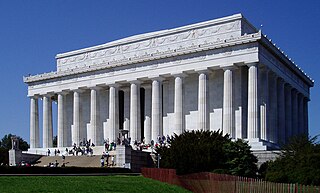
Henry Bacon was an American Beaux-Arts architect who is best remembered for the Lincoln Memorial in Washington, D.C., which was his final project.

Embassy Row is the informal name for a section of Northwest Washington, D.C. with a high concentration of embassies, diplomatic missions, and diplomatic residences. It spans Massachusetts Avenue N.W. between 18th and 35th street, bounded by Scott Circle to the south and the United States Naval Observatory to the north; the term is often applied to nearby streets and neighborhoods that also host diplomatic buildings, such as Kalorama.

The Washington Hilton is a hotel in Washington, D.C. It is located at 1919 Connecticut Avenue, N.W., roughly at the boundaries of the Kalorama, Dupont Circle, and Adams Morgan neighborhoods.

Cultural Tourism DC is an independent non-profit coalition of more than 230 culture, heritage, and community-based organizations in Washington, DC. Cultural Tourism DC and its members develop and present programs in Washington for area residents and visitors. Member organizations represent cultural and community organizations throughout Washington, DC; they include large institutions such as the John F. Kennedy Center for the Performing Arts and U.S. National Arboretum to smaller ones such as the Frederick Douglass House and the Hillwood Estate, Museum & Gardens.

Mihran Mesrobian was an Armenian-American architect whose career spanned over fifty years and in several countries. Having received an education in the Academy of Fine Arts in Constantinople, Mesrobian began his career as an architect in Smyrna and in Constantinople. While in Constantinople, Mesrobian served as the palace architect to the last Ottoman Sultan, Mehmed V.
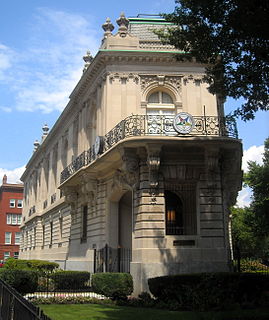
The Perry Belmont House, sometimes referred to as the International Temple of the Order of the Eastern Star, though there are no ritual or ceremonial spaces in the building, is the world headquarters of the General Grand Chapter of the Order of the Eastern Star, one of several organizations affiliated with Freemasonry. The building is located at 1618 New Hampshire Avenue, Northwest in the Dupont Circle neighborhood of Washington, D.C. The International Temple was added to the National Register of Historic Places on May 8, 1973.

The Sulgrave Club is a private women's club located at 1801 Massachusetts Avenue NW on the east side of Dupont Circle in Washington, D.C. The clubhouse is the former Beaux-Arts mansion on Embassy Row built for Herbert and Martha Blow Wadsworth and designed by noted architect George Cary. During World War I the Wadsworth House was used as the local headquarters for the American Red Cross.

The Golden Triangle is a neighborhood and business improvement district (BID) in Washington, D.C. Covering 43 blocks, it encompasses the western part of Washington's central business district, running from the front yard of the White House's north side to Dupont Circle and from 16th Street NW to 21st Street NW and including sections of K Street and Connecticut Avenue. The commercial neighborhood is home to more than 3,000 organizations, 200 restaurants, 300 shops and retailers, 7 hotels, and 6 national parks.

The Fraser Mansion is a building at 1701 20th Street NW, at the intersection of Connecticut Avenue, 20th Street, and R Street in the Dupont Circle neighborhood of Washington, D.C. Since its construction in 1890, the mansion has served as a private residence, a restaurant, a boarding house, the home of the Founding Church of Scientology, and—currently—the location of Scientology's National Affairs office.
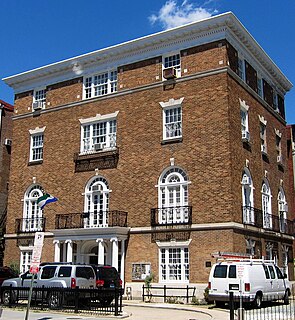
The Embassy of Sierra Leone in Washington, D.C. is the Republic of Sierra Leone's diplomatic mission to the United States. It is located at 1701 19th Street NW, in the Dupont Circle neighborhood.
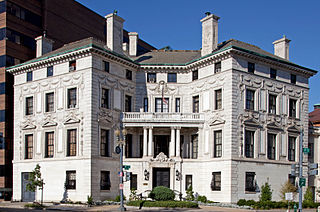
The Patterson Mansion is a historic Neoclassical-style mansion located at 15 Dupont Circle NW in Washington, D.C., in the United States. It was built by Robert Wilson Patterson, editor of the Chicago Tribune newspaper, and used by him and his family for entertaining when he was in the city. Completed in 1903, it was deeded to the American Red Cross in 1948. The Red Cross sold it to the Washington Club in 1951. The structure was renovated and a small, two-story addition added in 1955. As of December 2013, the property was up for sale after plans to convert it into a boutique hotel fell through. In June 2014, the Washington Club sold the mansion for $20 Million to developer SB-Urban. The Washington Club sold the property because "it is disbanding and no longer needs the space, according to John Matteo, an attorney at Jackson & Campbell, who represented the club in the sale."
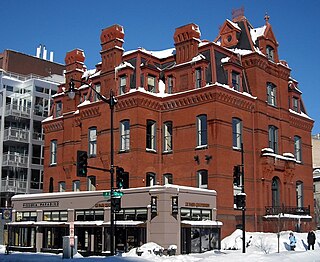
The James G. Blaine Mansion, commonly known as the Blaine Mansion, is an historic house located at 2000 Massachusetts Avenue NW, in the Dupont Circle neighborhood of Washington, D.C. The imposing house was completed in 1882 for James G. Blaine, a Republican politician from Maine who served as Speaker of the House, and later as a US Senator and US Secretary of State. He was also a presidential candidate who was narrowly defeated by Grover Cleveland in the 1884 United States presidential election.

Harvey Lindsley Page was an architect who built many well known structures in Washington, D.C., and San Antonio, Texas.

Stewart's Castle, also referred to as Castle Stewart or Stewart's Folly, was a mansion in Washington, D.C., located on the north side of Dupont Circle between Connecticut Avenue and Massachusetts Avenue. The house owed its various names to the original owner, Senator William Morris Stewart, the imposing, turreted facade, and its prominence in an area considered undesirable at the time of its construction. Designed by architect Adolf Cluss, the house was completed in 1873 but only stood for 28 years. It was badly damaged in a fire in 1879 but later repaired and rented to the Chinese Legation from 1886 to 1893. The house was sold to Senator William A. Clark, who razed it in 1901, intending to build a new residence. The plans never came to fruition. The site remained vacant for over 20 years until the construction of a commercial building, which still stands.

The Demonet Building is composed of a historic townhouse and adjoining office building on the southeast corner of Connecticut Avenue and M Street NW in Washington, D.C. Constructed in 1880, the townhouse is the last Victorian residence on Connecticut Avenue between Dupont Circle and Farragut Square that has not been significantly altered. It features an octagonal tower topped by a dome with cartouche windows. Following a multi-year legal battle to demolish the townhouse, which had been added to the District of Columbia Inventory of Historic Sites in 1979, the Demonet Building and adjoining lot were sold for what was then a record price for downtown real estate. The adjoining office building, designed by Skidmore, Owings & Merrill, was completed in 1984.

The Codman Carriage House and Stable is a historic building located at 1415 22nd Street NW in the Dupont Circle neighborhood of Washington, D.C. The industrial building was constructed in 1907 as a carriage house and stable for socialite and art collector Martha Codman Karolik, who lived a few blocks north in the Codman–Davis House. The Second Empire style building was designed by Karolik's cousin, architect, and prominent interior decorator Ogden Codman Jr., who also designed her home.
Daniel Boone Clarke Waggaman was an architect, designer, and lawyer. He designed residences, apartments, commercial buildings, townhouses, and country estates throughout America, most notably the Washington, D.C. districts: Dupont Circle, Sheridan Kalorama, Massachusetts Ave. Heights, West End, and Connecticut Ave.





















